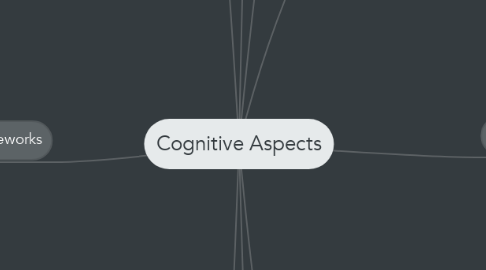
1. Attention
1.1. The process of selecting things to concentrate on, at a given point in time
1.1.1. Scanning the football results in a newspaper to attend to information about how our team has done
1.1.2. Our goals
1.1.2.1. If we know exactly what to find out, we try to match this with the information that is available.
1.1.2.2. If we are not etirely sure about what we are looking for, we may browse through information, which would guide our attention to irrelevant topics
1.1.3. Information presentation
1.1.3.1. The way information is displayed can influence how hard it is to find the necessary pieces of information
2. Perception
2.1. How information is acquired from the environment, via the different sense organs: Eyes, ears, fingers. And transformed into experiences.
2.1.1. Many web designers recommend using blank space when grouping objects together on a screen. This helps user locate items more easily
2.1.1.1. But other researchers suggest that too much blank space can be exaggerated and making it harder to find information
3. Cognitive Frameworks
3.1. Internal
3.1.1. Mental models
3.1.1.1. Used by people to reason about a system and to try to fanthom out what to do when something unexpected happens with the system
3.1.1.2. Transparency
3.1.1.2.1. Useful feedback in response to user input
3.1.1.2.2. Easy-to-understand and intuitive ways of interacting with the system
3.1.1.3. Level of information
3.1.1.3.1. Clear and east-to-follow instructions
3.1.1.3.2. Appropiate online help and tutorials
3.1.1.3.3. Context-sensitive guidance for users
3.1.1.4. Internal constructions of some aspect of the external world that are manipulated, enabling predictions and inferences to be made
3.1.2. Gulfs of execution and evaluation
3.1.2.1. The gaps that exist between the user and the interface
3.1.2.1.1. Show how to design the latter to enable the user to cope with them
3.1.2.2. The Gulf of execution
3.1.2.2.1. The distance from the user to the physical system
3.1.2.3. The Gulf of evaluation
3.1.2.3.1. The distance from the physical system to the user
3.1.3. Information processing
3.1.3.1. The mind is an information processor
3.1.3.1.1. Information is thought to enter and exit the mind through a series of ordered processing stages.
3.1.3.2. Processing stages
3.1.3.2.1. Various processes are assumed to act upon mental representations.
3.1.3.2.2. Comparing and matching
3.1.3.3. Provides a basis from which to make predictions about human performance.
3.2. External
3.2.1. Distributed cognition
3.2.1.1. Studies the nature of cognitive phenomena across individuals, artifacts, and internal and external representations
3.2.2. External cognition
3.2.2.1. Explaining the cognitive processes involved when we interact with different external representations
3.2.2.2. Explicate the cognitive benefits of using different representations for different cognitive activities and the processes involved
3.2.2.2.1. Externalizing to reduce memory load
3.2.2.2.2. Computational offloading
3.2.2.2.3. Annotating and cognitive tracing
3.2.3. Embodied interaction
3.2.3.1. Work that focuses on the emotional quality of interaction with technology, on publicly available actions in physically shared spaces
3.2.3.2. Ways that people experience the world through physical interaction, but still emphasize the value of using abstraction from particular contexts
4. What is cognition?
4.1. Thinking
4.1.1. Remembering
4.1.1.1. Learning
4.1.1.1.1. Daydreaming
4.2. General Modes
4.2.1. Experiential Cognition
4.2.1.1. A state of mind in which we... to events around us effectively and effortlessly
4.2.1.1.1. Percieve
4.2.1.1.2. Act
4.2.1.1.3. React
4.2.1.2. Driving a car
4.2.1.2.1. Reading a book
4.2.2. Reflective Cognition
4.2.2.1. Leads to new ideas and creativity
4.2.2.1.1. Thinking
4.2.2.1.2. Comparing
4.2.2.1.3. Decision Making
4.2.2.2. Designing
4.2.2.2.1. Learning
4.3. Attention
4.3.1. Perception
4.3.1.1. Memory
4.3.1.1.1. Learning
5. Memory
5.1. Recalling various kinds of knowledge that allow us to act appropiately.
5.1.1. Recognize someone's face
5.1.1.1. Remember someone's name
5.1.1.1.1. Recall when we last met them
5.1.2. Filtering process
5.1.2.1. Encoding takes place determining which information is attended in the environment and how it is interpreted
5.1.2.2. The extent of the last affects our ability to recall that information later
5.1.2.3. The more attention that is paid to something and the more it is processed, the more likely it is to be remembered
6. Learning
6.1. How to use a computer-based application
6.1.1. Set of instructions
6.2. Using a computer-based application to understand a given topic
6.2.1. Interactive interfaces easily manipulated
6.3. Learning through a set of instructions in a manual is unintuitive, boring and annoying.
6.3.1. On the other hand, learning through direct manipulation interfaces, which are good environments for supporting active learning
7. Reading, Speaking, and Listening
7.1. The three forms of language processing that have similar and different properties
7.1.1. The meaning of sentences or phrases is the same regardless of the mode in which it is conveyed
7.1.1.1. The sentence "Computers are a wonderful invention" has the same meaning even if someone reads it, speaks it, or hears it
7.1.2. Written Language
7.1.2.1. Permanent
7.1.2.1.1. Information can be re-read if not understood the first time around
7.1.2.2. Fast
7.1.2.2.1. Reading can be quck as written text can be rapidly scanned
7.1.2.3. Grammatical
7.1.2.3.1. Spelling check, minimal errors. Punctuation.
7.1.2.4. Dyslexics
7.1.2.4.1. Have difficulties understanding and recognizing written words
7.1.3. Listening Language
7.1.3.1. Transient
7.1.3.1.1. Information being broadcasted cannot be repeated (without external means)
7.1.3.2. Low Effort
7.1.3.2.1. Requires less cognitive effort than reading or speaking
7.1.3.3. Freedom
7.1.3.3.1. People often start talking and stop in mid-sentence, letting someone else start speaking
7.1.3.4. Hearing Impaired
7.1.3.4.1. Some people have trouble understanding spoken words

